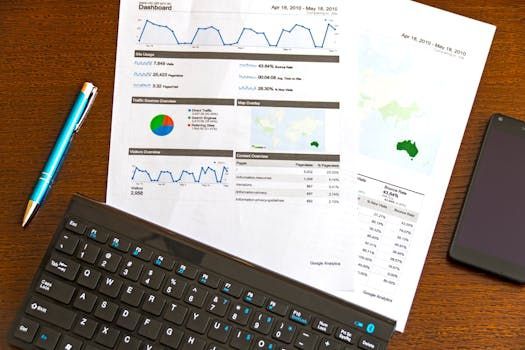How to Create Realistic Financial Projections for Your Business Plan
Understanding the Purpose of Financial Projections
Financial projections are a cornerstone of any business plan, serving as a roadmap for future success. They provide a clear view of how your business is expected to perform financially over a specific period, making them essential for securing funding, allocating resources efficiently, and guiding strategic decisions. Investors and lenders rely heavily on these projections to assess the viability of your business before committing their support.
Beyond attracting funding, financial projections help you anticipate potential challenges and opportunities. By understanding cash flow patterns, revenue streams, and expense trends, you can make informed decisions that keep your business on track. This forward-thinking approach not only builds confidence in stakeholders but also equips you with tools to navigate uncertainties effectively.
Key Components of a Financial Projection
The backbone of realistic financial projections includes three critical documents: the pro forma income statement, cash flow statement, and balance sheet. The pro forma income statement outlines expected revenues, costs, and profits. It gives a snapshot of whether your business model is sustainable and profitable under projected conditions.
Your cash flow statement tracks the inflow and outflow of cash, ensuring you have enough liquidity to cover operational expenses. This document is especially crucial because even profitable businesses can fail without proper cash management. Lastly, the balance sheet provides an overview of your company's assets, liabilities, and equity at a given point in time, offering insights into your financial health.
Together, these components create a comprehensive picture of your business's financial standing. When crafted accurately, they enable you to communicate your vision clearly to stakeholders while aligning internal operations with long-term goals.
Collecting and Analyzing Relevant Financial Data
To build reliable financial projections, you need to start with accurate data. Historical financial records from previous years are invaluable, as they highlight patterns in sales, expenses, and profitability. Additionally, conducting thorough market research helps identify external factors like industry benchmarks, economic trends, and customer behavior that could influence your business.
Analyzing this data allows you to spot trends, such as seasonality or growth drivers, which can shape your assumptions. For instance, if your business experiences higher sales during holiday seasons, factoring this into your projections ensures greater accuracy. By grounding your forecasts in solid evidence, you increase the credibility of your business plan.
Developing Realistic Assumptions for Projections
Setting realistic assumptions is one of the most challenging yet vital aspects of creating financial projections. Sales forecasts, expense estimates, and growth rates should be grounded in verifiable data rather than wishful thinking. Overly optimistic projections can mislead investors and set unrealistic expectations internally.
Avoid common pitfalls by setting measurable goals tied to tangible metrics. For example, instead of assuming exponential growth without justification, base your estimates on historical performance and market analysis. Collaborating with experts or consulting services like Yeppystl can provide additional perspective and enhance the accuracy of your assumptions.
Remember, assumptions act as the foundation of your projections. If they're flawed, everything built upon them will be too. Taking the time to validate your inputs ensures that your financial forecasts remain credible and actionable.
Step-by-Step Guide to Creating Pro Forma Financial Statements
Creating pro forma financial statements begins with gathering all necessary inputs, including sales forecasts, cost structures, and capital expenditures. Start with the income statement by estimating revenues and subtracting direct costs and operating expenses to calculate net profit. Ensure each line item reflects realistic assumptions based on your research.
Next, move to the cash flow statement. Here, detail when cash enters and leaves your business, accounting for timing differences between sales and payments. Be sure to include non-operational cash flows, such as loan repayments or asset purchases, to avoid surprises down the road.
Finally, construct the balance sheet by listing assets, liabilities, and equity at the end of the projection period. Each component must tie back to the income statement and cash flow statement to maintain consistency. With careful structuring, these documents form a cohesive narrative about your business’s financial trajectory.
Scenario Analysis: Building Flexible Projections
Preparing multiple scenarios—base, optimistic, and pessimistic—adds flexibility to your financial projections. This approach accounts for variables outside your control, such as economic downturns or unexpected market shifts. By presenting different outcomes, you demonstrate preparedness and resilience to stakeholders.
Scenario analysis isn’t just about risk management; it also aids in strategic planning. Understanding how various conditions affect your bottom line allows you to develop contingency plans and prioritize initiatives accordingly. Whether you’re pitching to investors or guiding internal decisions, flexible projections showcase adaptability and foresight.
Best Practices for Financial Forecasting
Collaboration across departments is key to crafting robust financial forecasts. Sales teams, marketing specialists, and finance professionals bring unique insights that enrich the accuracy of your projections. Regular communication ensures alignment and reduces the risk of overlooking critical details.
Another best practice is scheduling routine reviews and updates. Markets evolve, and so should your projections. Tracking forecast accuracy against actual results highlights areas for improvement and fosters continuous learning. Focus on measurable metrics to evaluate performance objectively.
Lastly, leverage technology to streamline the forecasting process. Tools like spreadsheets or specialized software simplify calculations and visualization, allowing you to focus on strategy. Services like Yeppystl offer expertise and resources to optimize your forecasting practices further.
Common Mistakes to Avoid When Projecting Financials
One frequent mistake is failing to maintain consistency in data sources. Mixing outdated figures with current estimates creates unreliable projections. Similarly, ignoring historical performance leads to unrealistic assumptions. Relying solely on gut feelings instead of verified data undermines credibility.
Neglecting cash flow is another costly error. Even businesses with strong sales can struggle if they don’t manage liquidity effectively. Always cross-check your projections against industry benchmarks to ensure they align with broader trends. Addressing these issues early strengthens both your forecasts and overall business strategy.
Using Financial Projections to Inform Business Decisions
Financial projections serve as more than just numbers on paper—they guide real-world decision-making. Use them to allocate budgets wisely, set achievable targets, and evaluate the feasibility of new projects. For example, if expanding to a new market seems promising, your projections can reveal whether the investment aligns with your financial capacity.
These forecasts also play a pivotal role in strategic planning. By simulating different scenarios, you can weigh risks and rewards before committing resources. Remember, business planning is iterative; regularly revisiting your projections ensures they remain relevant amid changing circumstances.
Ultimately, well-crafted projections empower you to make informed choices that drive growth and sustainability. They transform abstract ideas into actionable strategies, positioning your business for long-term success.
Tools and Templates for Building Financial Projections
Modern tools make building financial projections easier than ever. Spreadsheets like Microsoft Excel or Google Sheets are versatile options for small businesses, offering customizable templates and formulas. Accounting software such as QuickBooks integrates seamlessly with financial data, automating many calculations.
For larger enterprises, specialized forecasting tools provide advanced features like scenario modeling and real-time analytics. Choosing the right method depends on your business size and complexity. Regardless of the tool, prioritize usability and compatibility with your existing systems to maximize efficiency.
Regular Monitoring and Updating of Financial Forecasts
Financial projections aren’t static documents—they require ongoing attention. Establishing a formal review schedule ensures your forecasts stay aligned with reality. Quarterly updates are ideal, though significant events like regulatory changes or market disruptions may warrant immediate revisions.
Updating forecasts based on new data keeps your business agile. For instance, if actual sales exceed expectations, adjust your projections to reflect this trend. Consistent monitoring not only improves accuracy but also enhances your ability to respond swiftly to emerging opportunities or threats.
How Lenders and Investors Use Your Financial Projections
Lenders and investors scrutinize financial projections to gauge your business’s potential for success. They pay close attention to revenue growth, profitability margins, and cash flow stability. Strong projections instill confidence by demonstrating a clear path to repayment or return on investment.
Robust financials also highlight your understanding of the market and commitment to sound management practices. By presenting detailed, realistic projections, you improve your chances of securing funding and fostering trust among stakeholders.
Frequently Asked Questions
What time period should my financial projections cover?
Typically, projections should span at least three years, with monthly breakdowns for the first year and quarterly or yearly for subsequent years. This timeline balances detail with practicality, providing a comprehensive view of short- and medium-term performance.
How do I predict sales and revenue accurately?
Predicting sales involves combining historical data, market research, and realistic assumptions about customer acquisition and retention rates. Focusing on tangible drivers ensures your forecasts are grounded in reality rather than speculation.
Should I create more than one financial scenario?
Yes; preparing base, optimistic, and pessimistic scenarios prepares you for different outcomes and improves planning. Scenario analysis demonstrates adaptability and helps mitigate risks associated with uncertainty.
What’s the difference between financial forecasting and budgeting?
Forecasting projects possible future outcomes based on trends and assumptions, while budgeting sets specific limits and targets for operations. Both processes complement each other but serve distinct purposes in financial management.
How often should I update my financial projections?
Projections should be updated regularly—at least quarterly—and whenever significant events or trends emerge that could impact business performance. Frequent updates ensure your forecasts remain relevant and actionable.
Conclusion
Realistic financial projections are indispensable tools for any business plan. Grounded in accurate data, logical assumptions, and regular reviews, they guide decision-making, secure funding, and foster growth. By leveraging best practices and modern tools, you can create projections that not only impress stakeholders but also drive meaningful action within your organization.
Gather your historical data, research realistic assumptions, and begin building your own financial projections today. Remember, these projections are adaptable and serve as a strategic asset, helping you navigate challenges and seize opportunities. With dedication and precision, your financial forecasts will become a cornerstone of your business’s success.


